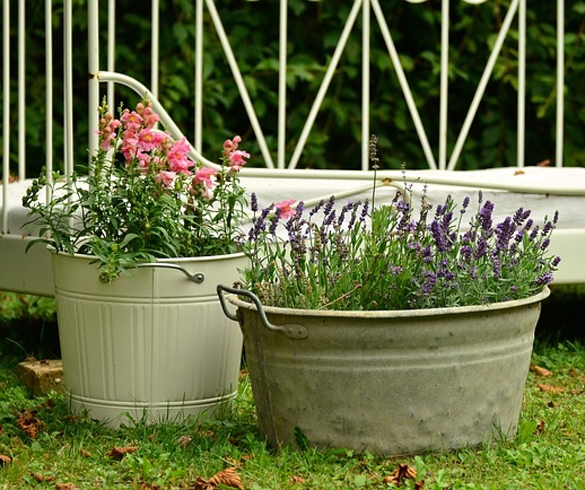
Garbage-Can Gardening
– It\’s mid-winter and the kids are clamoring for things to do. Outdoor play is great, but here\’s a fun indoor planting activity to offer when the weather is lousy. With little effort and a pinch of creativity you can devise some very imaginative indoor gardens! One of my favorites is the garbage-can garden.
Garbage-can gardening is when you grow plants from items you\’d normally throw in the garbage can (or compost bucket). Kids love this idea and it\’s a great way to reinforce sustainable living concepts such as recycling, reusing, and composting. Plus, it\’s a kick to grow new plants from old plant parts.
First, scout your kitchen and refrigerator for potential vegetables and fruits. Some of the best are oranges, lemons, limes, potatoes, sweet potatoes, avocadoes, carrots, beets, onions, and ginger. Believe it or not, you can use all of these, and many other vegetables and fruits, to propagate new plants. Here\’s how to start your garbage-can garden.
Starting Little Seeds
Citrus are plentiful in winter and the seeds in oranges, lemons, grapefruit, and limes are easy to grow into new trees. Fill a 4-inch-diameter pot with moistened potting soil. Remove whole seeds from the fruit and plant three to four of them one inch deep in the pot. The seeds should sprout in two to four weeks and you\’ll have a mini citrus orchard. Keep the seedlings well watered for about six weeks and then transplant individual trees into bigger pots. It will be quite a while before you see citrus flowers (let alone fruit), but the leaves smell like whatever citrus you\’re growing so be sure your children do some \”rub and sniff\” tests.
Starting Big Seeds
If the small seeds are a hit, try growing big seeds of tropical fruits such as mango and avocado. Let an avocado pit dry out for a day or two, then plant it in a 6-inch-diameter plastic pot filled with moistened potting soil. Leave the tip of the pit exposed to air. A fun way to sprout avocadoes is to suspend a pit over a glass of water. Poke three toothpicks around the middle of a pit and rest the toothpicks on the rim of the glass. Add water until it just touches the bottom of the pit. Kids can watch the roots and sprout emerge. Cool! It can take a month or two for roots to appear. If using the glass method, plant the pit in potting soil once a sprout emerges.
Mangoes are a little more difficult. Soak the hard seed for a week in warm water, replacing the water every day. Then pot it like an avocado and settle down for a wait: it can take up to four months for a sprout to emerge.
Off With Their (Carrot) Heads!
 You can force many root crops (beets, parsnips, and carrots, for instance) to sprout new growth by beheading them. Kids love the chopping part. Slice off the head end along with one to two inches of root and place it in a saucer filled with pebbles for support and water. In a week or so new greens should appear from the top. Then snug the root into a container filled with potting soil.
You can force many root crops (beets, parsnips, and carrots, for instance) to sprout new growth by beheading them. Kids love the chopping part. Slice off the head end along with one to two inches of root and place it in a saucer filled with pebbles for support and water. In a week or so new greens should appear from the top. Then snug the root into a container filled with potting soil.
This beheading technique also works well with pineapples. Cut off the top inch of the fruit and scoop out most of the yellow flesh inside the crown, leaving the core. Let the top dry for a day or two, then place it in a tray filled with pebbles for support and water. Roots will appear and new shoots will sprout from the top in about two weeks, and soon you\’ll have a fantastic tropical plant. To continue growing the new pineapple, transplant it into a pot, covering the crown and roots with soil.
New Tuber Plants
Tuberous roots – potatoes, sweet potatoes, and ginger – are another group of root crops that are easy to grow. Select old potatoes with eyes that are ready to sprout. The more shriveled the potato is, the better. Prop up the potato with toothpicks (like an avocado pit) over a water-filled glass or place a potato piece with one to two eyes in a container of moistened potting soil. Within a week a new sprout will emerge.
Ginger is particularly fun to grow because both the cut ends and the glossy new leaves (when broken) emit a strong gingery aroma. Suspend a chunk of ginger with toothpicks over a glass of water or place it in a container of moistened potting soil. If using the water method, transfer the new plant into a pot once roots appear.
Spicy Greens
For a garbage-can plant that\’s both smelly and edible, try garlic or onions. Plant old cloves of garlic or bulbs of onions just below the surface in containers filled with moistened potting soil. Within a few weeks you\’ll see sprouts. Unlike the other garbage-can plants described above, you can eat these greens in salads and stir-fries.
Garbage-Can Garden Design
Although it\’s fun and easy to grow each of these plants individually in its own pot, you can also make an indoor gardenscape for kids to play with once the original plants are established. Select a large container (16 inches in diameter or bigger) and fill the bottom third with empty plastic water bottles. Then fill the rest of the container with moistened potting soil. Have your kids select which plants to move into the big pot and start designing. You can make \”jungles\” for kids to populate with toy animals, city streets for toy cars, or exotic foreign \”worlds\” to explore. Make sure the pot gets three to five hours of sun a day and enough water and your kids will have an indoor play area that will grow for months, keeping them entertained and their imaginations stimulated without your constant input or a single high-tech gadget.
For more information on garbage-can gardening and other crops to grow, visit:
North Carolina State University
University of Phoenix
Gardens From Garbage: How to Grow Indoor Plants From Recycled Kitchen Scraps (The Millbrook Press, Inc., Brookfield, CT, 1993).
Charlie Nardozzi, a nationally recognized garden writer, book author, speaker and radio and television personality, has appeared on HGTV, PBS and Discovery Channel television networks. He is the senior horticulturist and spokesperson for the National Gardening Association (www.garden.org) and Chief Gardening Officer for the Hilton Garden Inn.
Source
National Gardening Association



